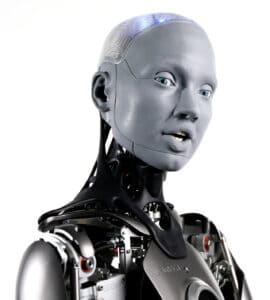
There’s a lot of chatter lately about chatbots and the artificial intelligence that helps them converse like a real person. Chatbots Decoded: Exploring AI is a new immersive exhibit that helps visitors navigate both the hopes and fears around this new technology.
Find out what chatbots are, why they matter, and where they come from. Interact with a chatbot-powered robot and some of the first chatbots, learn important lessons from history and insights from leading experts, and consider what just might come next.
Plan a visit to CHM or explore the exhibit online.

The exhibit features Ameca, a remarkable robot created by Engineered Arts. It uses state-of-the-art hardware, sensors, facial recognition software, and large language models, like Open AI’s GPT-4 to interact with visitors.
You can ask Ameca to answer questions, tell you a story in the style of your favorite writer, or create a rap song—in English, Mandarin, Japanese, Spanish, French, Portuguese, German, or Russian!